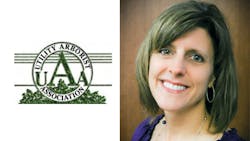Utility Arborist Association President's Letter
Some people say vegetation management on utility rights-of-way is like purchasing an insurance policy. That’s an interesting statement worth exploring in greater detail.
So, how is utility vegetation management (UVM) like an insurance policy? Insurance is purchased for those “what-if” scenarios. What if I break a leg? Or have heart attack? Or worse? How will my bills get paid or how will I provide for my family when I’m unable to pay the bills? These are all questions that most adults contemplate at some point in life. Insurance is there as a safety net to pick up the slack in times of need. When a utility company invests in a systematic UVM maintenance program, it provides some assurances against excess damage as a result of future catastrophic events, such as a major ice storm, hurricane or just the run-of-the-mill spring storm.
It can be a challenge, however, for utility management to ensure that limited resources are being used in the most cost-effective way. In many states, there is not a choice as to how to expend UVM dollars. In fact, there are many UVM regulations imposed on utilities across the nation having to do with everything from required clearances, to set cycles, to adherence to certain reliability metrics, to required annual UVM spends. Typically, these rules are enacted in the wake of a catastrophic event that caused major damage and extended outages. This leaves utilities, customers, regulators to question, after the fact, if something more could have been done to avert those large-scale interruptions. Utilities must balance several priorities — from safety and customer service to budget — when deciding on what level of vegetation management activities are warranted for their systems.
We as UVM managers must present all the pertinent information in a format that is impactful for the decision makers of our companies. The challenge is to create and foster relationships with regulators, federal agencies and others so that we can reduce the impact of large-scale events while keeping focused on priorities identified by our utilities.
To that end, the UAA along with Edison Electric Institute’s Vegetation Management Task Force has been revising and renewing the 2006 Memorandum of Understanding (MOU) signed by the U.S. Department of Agriculture Forest Service, Bureau of Land Management, Fish and Wildlife Service, National Park Service and the U.S. Environmental Protection Agency. The 2006 agreement states that electric utilities provide an essential service tied closely to the nation’s safety, economy and welfare. The MOU provides a framework to establish cooperative rights-of-way integrated vegetation management (IVM) practices that are practical, sustainable and cost-effectively reduce risks to the environment and the public while ensuring uninterrupted electrical service to customers. These practices include the guiding principles of IVM: set objectives, evaluate the site, define action thresholds, implement IVM, monitor treatment and quality assurance.
The MOU facilitates compliance with reliability and safety standards, including NERC reliability standard and Energy Policy Act of 2005. It also focuses on improving worker safety and reducing risks to human health, natural resources and the environment; this should reduce wildfire risk, reduce erosion, improve water quality and promote local ecotypes.
So, as we evaluate our UVM programs, there are numerous issues to consider and weigh to ensure we are being good stewards of our limited resources. The UAA stands ready to assist its members, and the annual Transmission & Distribution World Vegetation Management supplement is a tool available to UVM managers. In addition, the UAA is supporting and participating in the Right-of-Way Stewardship program. This proactive industry initiative will serve to formally recognize excellence in application and practice of IVM in North America (see T&D World June 2012 for more details).
We continue place high value in the relationship with T&D World magazine and will participate in any way that makes sense and benefits our membership. We have benefitted from more than nine years of providing support and educating the readership of the magazine. If you have any topic UAA executive committee or any of the standing committees. Please visit our website at www.utilityarborist.org.
Sincerely,
Anne Beard
President of the Utility Arborist Association

